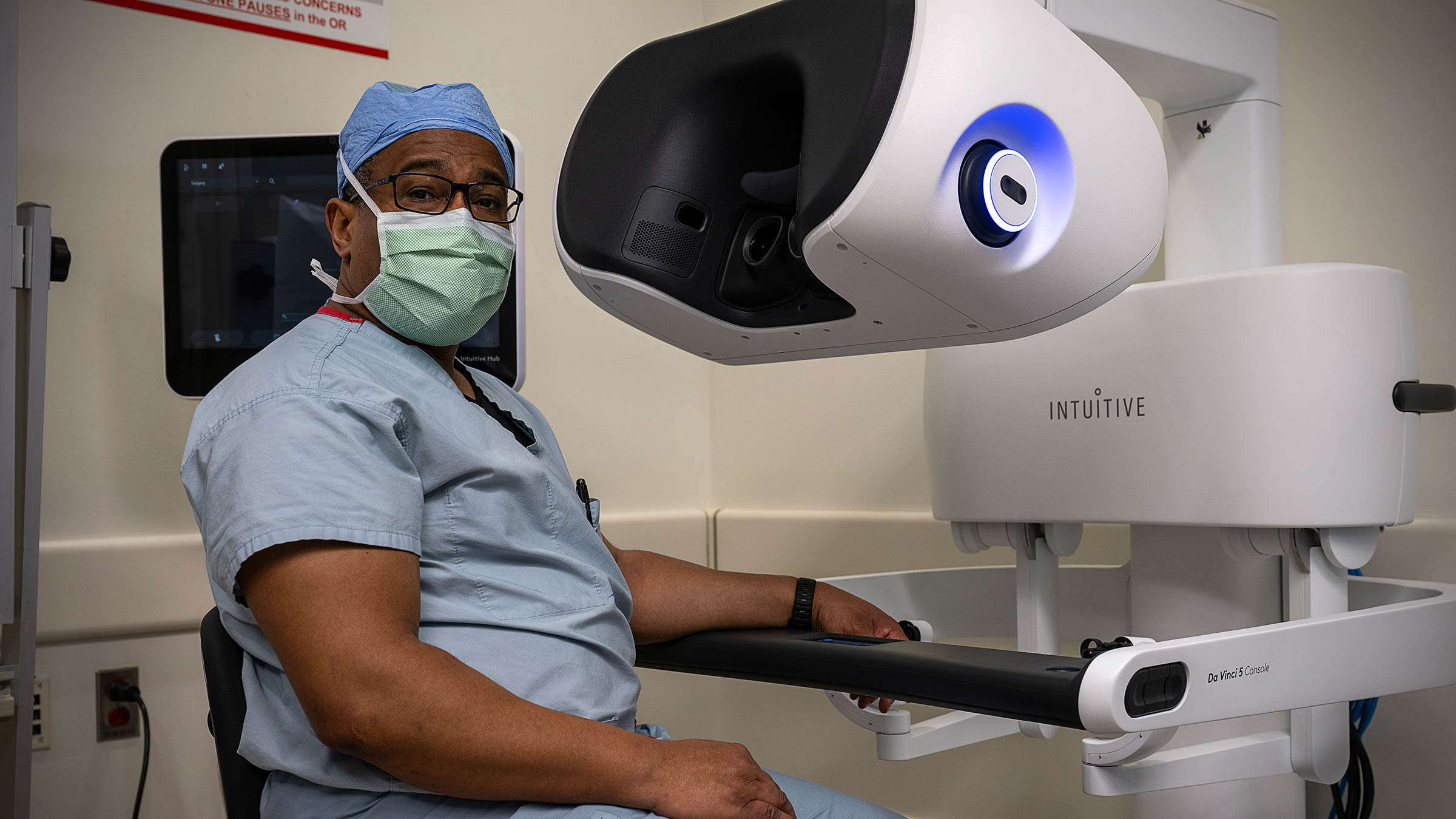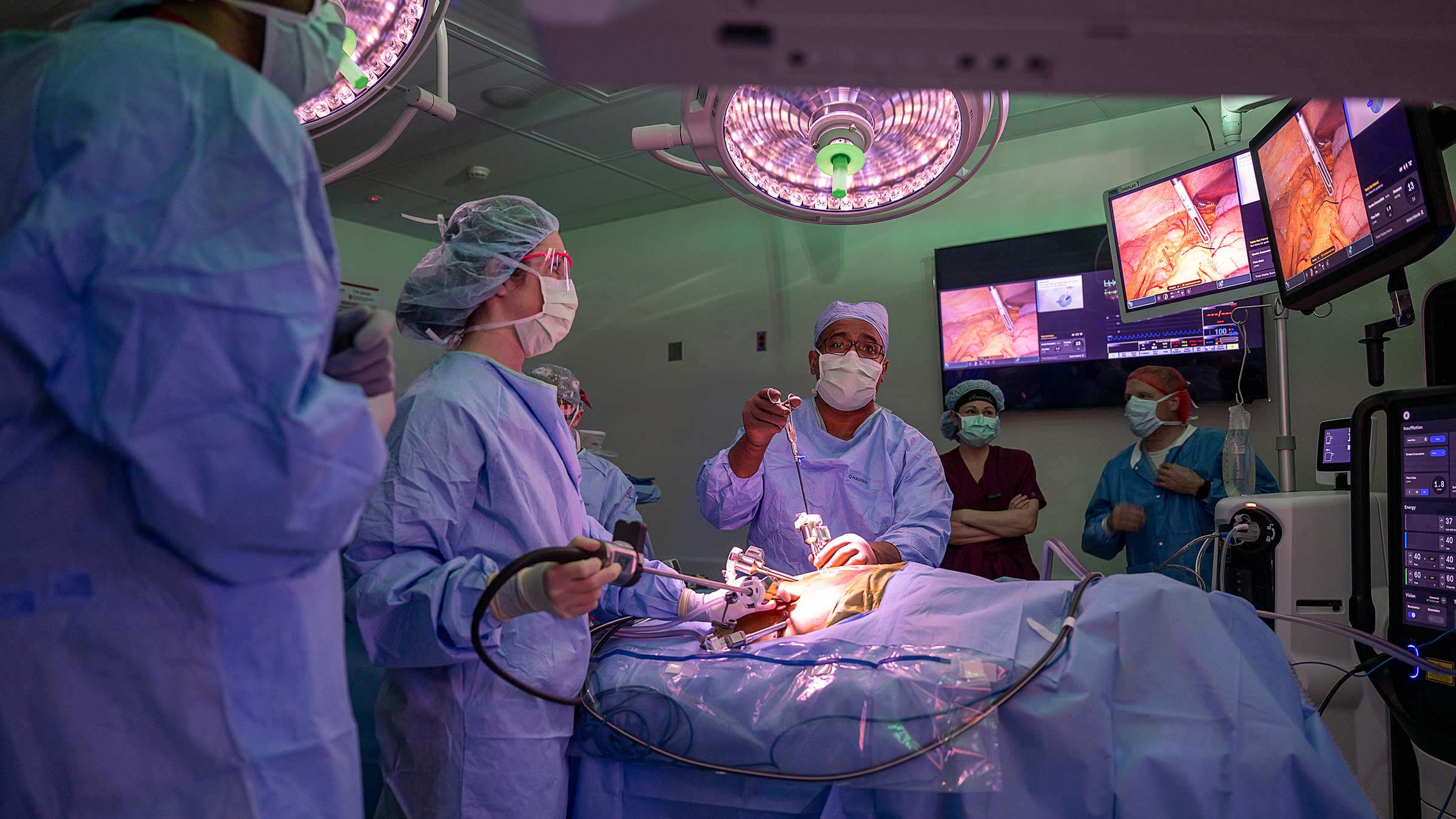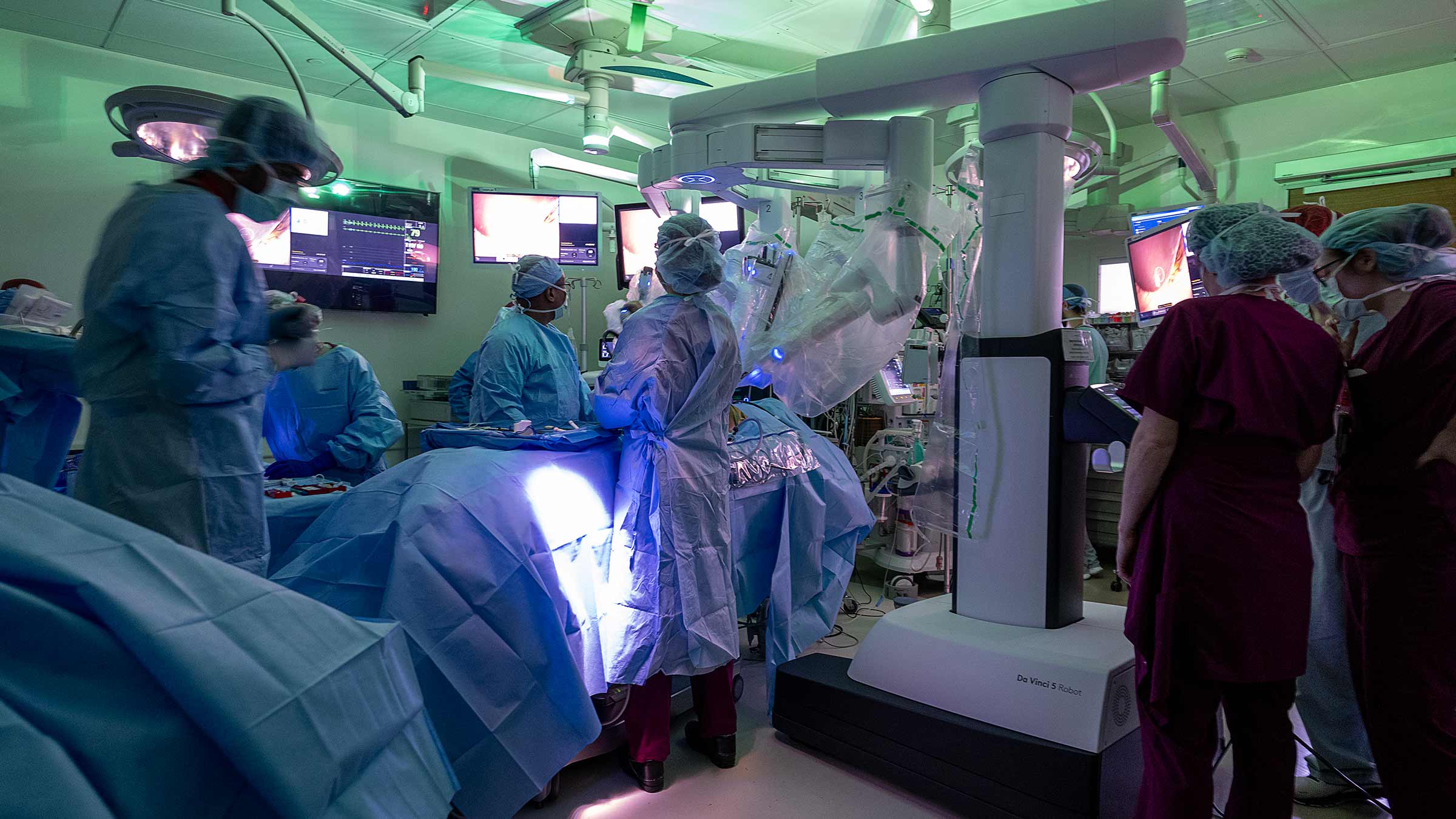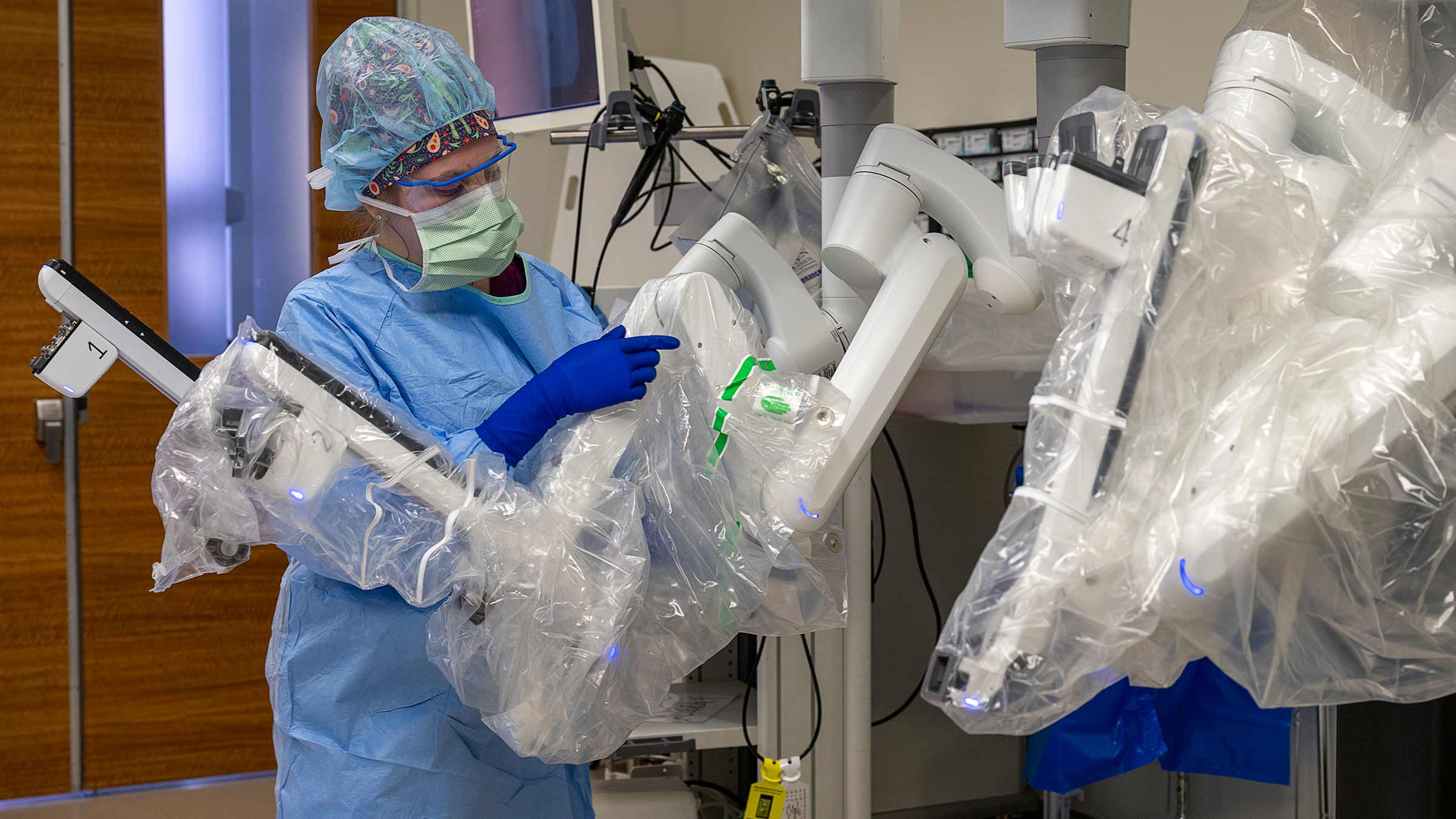Leading the next generation of robotic surgery technology
With technology making a ‘massive leap forward,’ the da Vinci 5 surgical robot promises better outcomes for patients.
The sounds of popping and beeping come from a sleek, modern machine with four mechanical arms placed into a patient’s abdomen through four small incisions.
The sounds may be reminiscent of a vintage computer console or a space robot in the movies, but the machine itself is the latest generation da Vinci 5, the most upgraded version of the surgical robot.
Robert Merritt, MD, a thoracic surgeon at The Ohio State University Comprehensive Cancer Center – Arthur G. James Cancer Hospital and Richard J. Solove Research Institute (OSUCCC – James) and division director of Thoracic Surgery at The Ohio State University College of Medicine, completed the first da Vinci 5 surgeries at Ohio State in early April. Physicians from Ohio State cleared the device's path to getting its benefits to the public.
He sits in the corner of the operating room behind a console. His head rests within a visual panel, giving him an exceptional view into the surgical area.
“The da Vinci 5 feels pretty good,” he says, of using it in the first surgeries. “It will certainly enhance surgeons’ ability to do these operations more efficiently and hopefully with better outcomes.”

From the console, Dr. Merritt controls the surgery and the operating room. He calls out what suture materials are needed next over a microphone.
The view through the console shows crisp, sharp visuals of the patient’s anatomy in 3D. The same images are shown on monitors throughout the operating room.
Dr. Merritt’s hands work the controls of the da Vinci 5 and his feet occasionally use the console’s pedals to divide a vessel that will be used to help connect the stomach with the esophagus.
Ohio State leads trials and testing of new surgical robot
Ten Ohio State surgeons are credited with helping the machine through clinical trials and FDA approval.
“This is the first robotic update for the system in a decade,” says Michael Meara, MD, MBA, associate professor of surgery in the Department of Surgery and medical director of robotic surgery at the Ohio State Wexner Medical Center. “From an under-the-hood standpoint, it’s a pretty massive leap forward.”
While robotic surgery isn’t new, some of the latest advances will be game-changing for both surgeons and patients.
Benefits of the new robot include:
- Less damage to patients’ tissue during surgery, leading to faster recovery times
- More precise surgical movements and technology
- Sharper surgical imagery
- Dynamic feedback to improve surgeon skills during training simulations
- 10,000 times more computing power
- Ohio State’s da Vinci 5, made by Intuitive, is only one of 10 operational models in the country and the first in the Midwest.
“Ohio State is certainly one of the busiest and highest volume robotic programs in the country,” Dr. Merritt says. “We have multiple surgical service lines that utilize robotic technology.”
Clinical trials conducted with patients showed the da Vinci 5 is safe for patients and performed just as well as previous surgical robots.
“We’re proud that the expertise of our clinical and research teams helped us be selected as one of the clinical trial sites for the latest da Vinci model.” Heidi Pieper, program director of Ohio State's Robotic and Minimally Invasive Surgery Program
Ohio State was the first institution to enroll in the trial and had the most patient participants. The first patients enrolled in December 2022 and the trial lasted for six months.
Cancer patients will continue to be monitored each year for five years to assess long-term outcomes.
“The trial went very well,” Dr. Merritt says. “The results were very good and our efforts in the study were instrumental in the FDA approving the da Vinci 5 robot.”

How the da Vinci 5 improves robotic surgery
During any type of surgery, surgeons handle delicate internal tissue and organs that must be cut or moved. The more tissue damage is reduced, the faster patients heal.
Tissue damage to patients is expected to be reduced by 43% compared to the previous model.
“There’s improved tactile feedback,” Dr. Merritt says.
Part of the latest upgrades include tremor controls for the surgeon, which make it a smoother and more precise system to use.
“The system will alert the surgeon when they’re exerting too much force on tissue, which certainly will result in less tissue damage. It will certainly translate to better patient outcomes,” Dr. Merritt says.
Additional updates could include incorporating advanced imaging, highlighting anatomic structures and even physically identifying cancer.

Better training for surgeons to become skilled at robotic surgery
Surgeons undergo extensive training before they step into their first robotic surgery. The da Vinci 5 can track every movement a surgeon makes while training and stores that information in a database.
It can develop algorithms that show the difference between precise expert surgeons’ movements and those of a novice.
Data show expert surgeons need far fewer movements to complete a surgery while less experienced surgeons tend to make more movements to complete the same surgery.
“One of the biggest barriers to robotic surgical training is training the eyes to learn what tissue tension ‘looks like’ versus how it feels in traditional surgical approaches,” Dr. Meara says. “The tactile feedback integrated into this new technology removes a big barrier for training. It alerts surgeons when there’s too much pressure, resulting in less tissue damage, and that translates to even more precise treatment at the bedside for the patient.”
Based on the surgeon’s technique, a da Vinci 5 simulator will recommend training in the areas the surgeon needs the most to improve.
“We can start drilling down on those particular skills in real time,” says Lori Welsh, robotic surgery education coordinator. “That’s very powerful. That’s data-driven education. They’re just scratching the surface with some of the data that we’re going to be getting.”
More than 100 people, including surgeons and operating room staff, were trained on the da Vinci 5 before the first surgeries.
“If the new robot is more efficient and easier for surgeons to use, then that will certainly translate into faster training, faster learning curves and then a faster simulation of the robotic skill set,” Dr. Merritt says.

A robot with a bigger brain
Many of the advances with the da Vinci 5 are ones that aren’t readily apparent.
“It’s like jumping from an iPhone 6 to an iPhone 15,” Dr. Meara says.
The new model has 10,000 times more computing power compared to the last model.
“It’s faster,” he says. “It’s able to perform tasks it could not do previously. It’s also able to acquire and interpret information on the fly that we couldn’t previously.”

Ohio State’s history of robotic surgery
That innovation is the latest chapter in the academic medical center’s storied robotics program dating back to 1999.
As of October 2024, Ohio State had completed more than 34,350 robotic surgeries in various specialties, including cardiac, transplant, ENT, colorectal, gynecology, urology, general surgery, thoracic surgery and surgical oncology since the program’s inception.
Two out of 16 robots in Ohio State’s surgical arsenal are da Vinci 5s.
“Ohio State has always had the outlook of, ‘Where can we take this technology?’” Dr. Meara says.
Ohio State’s robotics program has 80 surgeons from 14 surgical specialties and trains 168 surgical residents and fellows per year.A week out from surgery, the first da Vinci 5 patients are healing, and even more surgeries are underway.
“The surgeries went well,” Dr. Merritt says. “I think the goal is to use the robot in high-volume robotic centers and collect clinical trial data. Ultimately, that all translates to good patient outcomes.”

Your support fuels our vision to create a cancer-free world
Your support of cancer care and pioneering research at Ohio State can make a difference in the lives of today’s patients while supporting our work to improve treatment and reduce cases tomorrow.
Ways to Give



